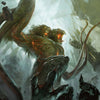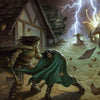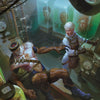3 D&D Character Introduction Mistakes to Avoid

Written by Luke Hart
RPG horror stories abound, but I was once told this story that left me flabbergasted. A new player – let’s call her Kate – was joining a D&D game, and the game master told her that once he introduced her character, she’d be jumping in to play. She was excited – I think it might have been her first game ever – and waited with anticipation. Well, as it turned out, it would end up taking THREE GAME SESSIONS before the game master was “able” to work her character into the ongoing narrative and story. So, for three sessions she sat there and waited, not playing the game, just watching.
It's horse crap like this that causes players to bounce off tabletop RPGs and go elsewhere. I mean, shoot, if that were my first game ever as a player, I would probably think that was normal and decide that tabletop RPGs were probably not my thing…
So, today we’re going to go over common character introduction mistakes that players probably hate and game masters should avoid. Whether a GM is introducing a new character because a new players is joining the group or because an existing character has died, there are certain things to avoid to overall improve your gaming experience.
Watch or listen to this article by clicking the video below.
Mistake #1 Not Introducing a New PC Quickly
Now, this mistake was probably obvious based on the opening story I shared. I understand that RPGs are a collaborative storytelling experience where the narrative is important and holes in the plot and story can affect immersion, but they are also GAMES that those participating expect to be involved in. Otherwise, why are they there?
Also, please note that I said RPGs are a COLLABORATIVE storytelling experience. How can a player collaborate if they are sitting on the sidelines for an extended period of time. So, no you don’t want to do something that destroys immersion and story, but you also need to consider the players’ feelings and desire to, you know, actually play the game. There is a BALANCE to be struck.
My personal goal when introducing a new character is to get them in the action almost immediately. Usually within 5 minutes we can get them plugged in so they can enjoy the game along with everyone else.
In my Sword Coast Guard campaign, when a new player Kevin joined the group, I plopped his paladin right down into the middle of an ongoing battle the moment he arrived to the game table, and we figured out the story reasons for his arrival later. Of course, Kevin’s paladin also happened to die within the first 15 minutes of that game, which lead to my first memorable Deux Ex Machina moment as a game master which you can watch here.
Mistake #2 Worrying Too Much About the Story
I feel like sometimes we game masters – and perhaps players as well – worry a bit too much about the ongoing story and feel that a new character joining the adventuring group and campaign must be organically justified, planned out just perfectly, and happen at just the right moment where it makes the most sense.
And the result of this is Kate’s story of waiting for three game sessions. You see, at some point, you have to ask yourself: is the PERFECT character introduction at the PERFECT moment really worth it if a player’s personal game experience suffers because of it?
Now, if you’re putting on an RPG show that caters to an audience, the suppression of what an individual player prefers might make sense: I mean, the goal of a show is to entertain an audience, not necessarily for cast members to have fun at all times.
But most of us are not putting on RPG shows; we’re just running private games for our friends. Furthermore, if we examine the breadth of the typical RPG campaign, new character introductions account for a minuscule percentage of the game. Thus, I submit that perhaps our concern over them should be proportionate.
Mistake #3 Not Worrying Enough About the Story
And we have come full circle! LOL “Okay, Luke, first you tell us NOT to worry about the story, and now you say we should.” Remember how I mentioned balance? Yeah, that’s what we’re going for here. Because if we completely disregard the ongoing narrative and introduce a new character without adequate backstory or context, we can make it difficult for other players to understand and connect with the new character. Everyone will be left thinking, “Okay great, this is the new guy. But why is he here? And why should I care?” There needs to be a WHY.
Why is that new character there in that moment? Why do they want to join the existing adventuring party? Why are they motivated to help the party with their current goals?
THOSE QUESTIONS MUST BE ANSWERED. There must be backstory and context for a new character joining a group, otherwise, immersion and the narrative suffers. So, yes, answer those questions; I’m just saying that it shouldn’t take you THREE GAME SESSIONS to do so.
Mistake #4 Not Outsourcing the Story
Look, the game master does NOT have to do everything. When I introduce a new character to the group, I ask the PLAYER to come up with why they are there, why they want to join the party, and why they want to help them with their goals.
All of these questions deal with PLAYER motivations, which, logically are the purview of the PLAYER. So, let them figure out the answers to those questions. This is not a GM problem; it’s a player problem.
And, frankly, when you allow your players to answer those questions, two things will happen: first, their answers will probably be better than whatever the game master would have come up with, and second, the player will feel much more invested in the story because they created and owned the answers to those questions.
Mistake #5 Mid-Adventure Floundering
Just a few weeks ago we had a players’ character die in the middle of a dungeon delve. Now, it just so happened it was the cleric, so no one else was able to raise them from the dead. However, we had enough party funds that we could easily pay for a raise dead back in town. Thus, we were forced with the classic dilemma: do we continue adventuring while that player basically doesn’t play the game, or do we leave the dungeon to get them resurrected?
Now, many times, being a PC down is untenable, and you really need them back to stand a chance. But, other times, the party is probably capable of pressing forward, especially if they are nearly done with the adventure.
Now, I don’t think there is a “correct” answer here, and as a game master I typically leave this decision up to the players: press on or go back to town for a rez. However, I will tell the group that they are WELCOME to press on in the adventure, because if they do, I’ll just loop in the player’s backup character so they can keep playing. And then, once the group is able to get back to town and the dead character is raised from the dead, the player can decide which character they want to continue playing. This allows the players the freedom to choose either option without worrying that one of the players will be sidelined and unable to play.
But, Luke, you might say, we don’t have backup characters! That’s cool. The player can make one right then and there. I personally have done this many times: my character dies – usually because I’m reckless as a player – and then while the rest of the group keeps on playing, I quickly put together another character. And then, once I’m done, the game master gets me back in the action.
How to Introduce a New Character
Now, right about now some of you are yelling at your screen about how I just did a lot of talking but didn’t actually tell you HOW to introduce a new character to the game. That is, you were looking for specific mechanisms and specific examples.
I have two things to say to that: First, only you and your players have enough knowledge about your campaign and the ongoing narrative to decide how best to introduce a new character. Second, I prefer to teach principles and concepts and then encourage YOU to exercise your own creativity with their implementation.
However, if you really want to know how I personally introduce new characters in my games, I have two tried and true methods:
#1 – If the group is in-between adventures in town, I have the new character arrive before the rest of the characters, and then I turn to the player and ask them, “Could you explain why you are here and why you want to join the group?”
#2 – If the group is in the middle of an adventure, I have the new character arrive before the rest of the characters, and then I turn to the player and ask them, “Could you explain why you are here and why you want to join the group?”
The fact is that introducing new characters to the game doesn’t have to be complicated. It can be as simple as what I usually do. However, I also respect that my method may not be your cup of tea, and you want to do something more elaborate and memorable – and that’s great. I am a firm believer that there is more than one way to cook bacon.
Confront Devious Fey and Their Tricksy Plots!
For years, the fey creatures inhabiting Pelview Grove to the north and Pelfell Bog to the east have not been a source of trouble, though perhaps they were a shade too mischievous at times. That has now changed.
Beset on all sides by a variety of issues -- childish pranks gone wild, dwarves forced out of their own brewery, and farmers missing -- the Aeredale guard is looking for help from local adventuring parties to set things right.
For those brave souls who accept the call to adventure, it'll be time to go into the fey.
If you’re looking to start up a new 5e campaign or reboot your current one, Into the Fey may be exactly what you need. Designed for levels 1 to 5, Into the Fey contains everything you need to start playing:
- Eleven fey-themed adventures for level 1 to 5 adventuring parties
- Over 40 new fey monsters
- The fully fleshed-out town of Aeredale
- Maps of Aeredale, the surrounding region, and the Fey Plane
- Player handouts
- Hag potion system
- 15 new fey magic items
- JPG image files of all Into the Fey adventure maps, including GM versions and gridded/non-gridded player versions
- JPG images files of all Into the Fey world maps
- Digital tokens of Into the Fey NPCs and monsters
Pick up the Into the Fey Ultimate Bundle to get the hardcover, the PDF, digital maps, and digital tokens.
Starting a new campaign can be tons of work; let Into the Fey do some of the heavy lifting for you!
-
Posted in
Game Master How-To Articles







